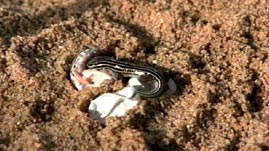For most living things, sexual reproduction has proven the best overall strategy to perpetuate a species in the rough-and-tumble, unpredictable fray of natural selection. With two partners combining varied genes, a species has more flexibility to adapt to changing environments.
There are, however, rare examples of asexual species that reproduce by cloning. Each offspring is genetically identical to the parent, with little variation generation after generation. (Mutations do create a minor amount of change.)
If asexual reproduction survives at all, conditions must sometimes favor it, even in competition for a niche with sexually reproducing species. Some insects, like aphids, are both asexual and sexual reproducers. Though rare, those species that reproduce asexually tend to persist.
Efficiency, for one thing, is on the side of asexual organisms: Without the need for males, every clonal individual passes a full set of identical genes onto the next generation. In addition, a single female can establish a new population. This gives asexual creatures on the fringes of a habitat an edge in colonizing a new one.
Clonal organisms with tolerance for a broad range of conditions also exist. Even if they do not vary much genetically, they possess what scientists have dubbed "general-purpose genotypes." One example is a type of minnow found in Minnesota that tolerates both highly oxygenated and poorly oxygenated waters. Able to survive in an unpredictable environment, this minnow outlasts more specialized strains.
Asexual animals arose from diversified sexually reproducing ancestors. Often they are hybrids between two different species, and may possess two complete sets of chromosomes. One such asexual organism is the whiptail lizard in the U.S. Southwest, Mexico, and South America, which consists only of females who reproduce by parthenogenesis. They appear to be the only known unisexual reptile.
Clones generally hit a dead end, going extinct when their limited variation collides with changing environmental conditions or with better-surviving sexual reproducers. With their unusual way of reproducing, they continue to fascinate scientists because they are natural experiments in interactions between fixed genotypes and varying environment.


 Loading Standards
Loading Standards Teachers' Domain is proud to be a Pathways portal to the National Science Digital Library.
Teachers' Domain is proud to be a Pathways portal to the National Science Digital Library.
